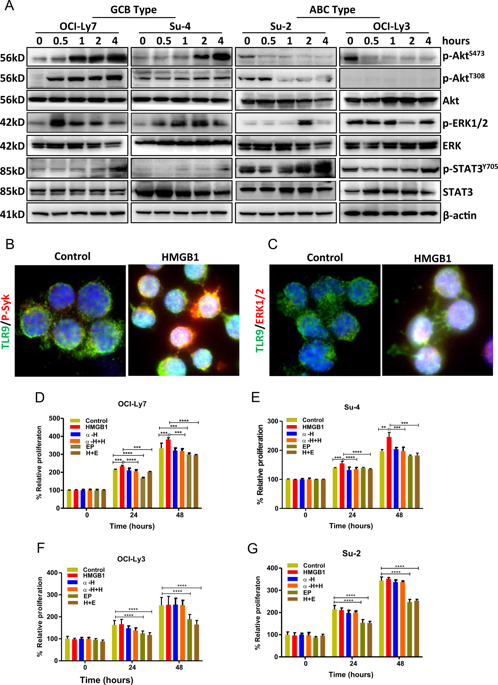当前位置:
X-MOL 学术
›
Cell Death Dis.
›
论文详情
Our official English website, www.x-mol.net, welcomes your
feedback! (Note: you will need to create a separate account there.)
Blockade of HMGB1 signaling pathway by ethyl pyruvate inhibits tumor growth in diffuse large B-cell lymphoma.
Cell Death & Disease ( IF 8.1 ) Pub Date : 2019-04-15 , DOI: 10.1038/s41419-019-1563-8 Tian Zhang 1 , Xu-Wen Guan 1, 2 , John G Gribben 3 , Feng-Ting Liu 1, 4 , Li Jia 1, 3
Cell Death & Disease ( IF 8.1 ) Pub Date : 2019-04-15 , DOI: 10.1038/s41419-019-1563-8 Tian Zhang 1 , Xu-Wen Guan 1, 2 , John G Gribben 3 , Feng-Ting Liu 1, 4 , Li Jia 1, 3
Affiliation

|
High mobility group box 1 (HMGB1) protein in the tumor microenvironment actively contributes to tumor progression but its role in diffuse large B-cell lymphoma (DLBCL) is unknown. The aim of this study was to determine the mechanism by which HMGB1 promotes tumor growth in DLBCL and whether blockade of HMGB1 signaling pathway could inhibit tumorigenesis. We report that HMGB1 promotes proliferation of DLBCL cells by activation of AKT, extracellular signal-regulated kinases 1/2 (ERK1/2), signal transducer and activator of transcription 3 (STAT3) and SRC Proto-Oncogene, Non-Receptor Tyrosine Kinase (Src). Ethyl pyruvate (EP), an anti-inflammatory agent, inhibits HMGB1 active release from DLBCL cells and significantly inhibited proliferation of DLBCL cells in vitro. Treatment with EP significantly prevented and inhibited tumor growth in vivo and prolonged DLBCL-bearing mice survival. EP significantly downregulated HMGB1 expression and phosphorylation of Src and ERK1/2 in mice lymphoma tissue. EP induced accumulation of the cell cycle inhibitor p27 but downregulated expression of cyclin-dependent kinase 2 (CDK2). Increased nuclear translocation of p27 interacted with CDK2 and cyclin A, which led to blockade of cell cycle progression at the G1 to S phase transition. In conclusion, we demonstrated for the first time that blockade of HMGB1-mediated signaling pathway by EP effectively inhibited DLBCL tumorigenesis and disease progression.
中文翻译:

丙酮酸乙酯阻断HMGB1信号通路可抑制弥漫性大B细胞淋巴瘤中的肿瘤生长。
肿瘤微环境中的高迁移率族1号框蛋白(HMGB1)积极地促进了肿瘤的进展,但其在弥漫性大B细胞淋巴瘤(DLBCL)中的作用尚不清楚。这项研究的目的是确定HMGB1促进DLBCL中肿瘤生长的机制以及HMGB1信号通路的阻断是否可以抑制肿瘤发生。我们报告HMGB1通过激活AKT,细胞外信号调节激酶1/2(ERK1 / 2),信号转导子和转录激活子3(STAT3)和SRC原癌基因,非受体酪氨酸激酶( Src)。丙酮酸乙酯(EP),一种抗炎药,抑制HMGB1从DLBCL细胞的活性释放,并在体外显着抑制DLBCL细胞的增殖。用EP处理可显着预防和抑制体内肿瘤的生长,并延长荷DLBCL的小鼠的存活率。EP显着下调小鼠淋巴瘤组织中HMGB1的表达以及Src和ERK1 / 2的磷酸化。EP诱导了细胞周期抑制剂p27的积累,但下调了细胞周期蛋白依赖性激酶2(CDK2)的表达。p27的核易位增加与CDK2和细胞周期蛋白A相互作用,从而导致细胞周期在G1到S相的转变中受阻。总之,我们首次证明了EP阻断HMGB1介导的信号通路有效抑制了DLBCL的肿瘤发生和疾病进展。EP诱导了细胞周期抑制剂p27的积累,但下调了细胞周期蛋白依赖性激酶2(CDK2)的表达。p27的核易位增加与CDK2和细胞周期蛋白A相互作用,从而导致细胞周期在G1到S相的转变中受阻。总之,我们首次证明了EP阻滞HMGB1介导的信号通路有效地抑制了DLBCL的肿瘤发生和疾病进展。EP诱导了细胞周期抑制剂p27的积累,但下调了细胞周期蛋白依赖性激酶2(CDK2)的表达。p27的核易位增加与CDK2和细胞周期蛋白A相互作用,从而导致细胞周期在G1到S相的转变中受阻。总之,我们首次证明了EP阻断HMGB1介导的信号通路有效抑制了DLBCL的肿瘤发生和疾病进展。
更新日期:2019-04-15
中文翻译:

丙酮酸乙酯阻断HMGB1信号通路可抑制弥漫性大B细胞淋巴瘤中的肿瘤生长。
肿瘤微环境中的高迁移率族1号框蛋白(HMGB1)积极地促进了肿瘤的进展,但其在弥漫性大B细胞淋巴瘤(DLBCL)中的作用尚不清楚。这项研究的目的是确定HMGB1促进DLBCL中肿瘤生长的机制以及HMGB1信号通路的阻断是否可以抑制肿瘤发生。我们报告HMGB1通过激活AKT,细胞外信号调节激酶1/2(ERK1 / 2),信号转导子和转录激活子3(STAT3)和SRC原癌基因,非受体酪氨酸激酶( Src)。丙酮酸乙酯(EP),一种抗炎药,抑制HMGB1从DLBCL细胞的活性释放,并在体外显着抑制DLBCL细胞的增殖。用EP处理可显着预防和抑制体内肿瘤的生长,并延长荷DLBCL的小鼠的存活率。EP显着下调小鼠淋巴瘤组织中HMGB1的表达以及Src和ERK1 / 2的磷酸化。EP诱导了细胞周期抑制剂p27的积累,但下调了细胞周期蛋白依赖性激酶2(CDK2)的表达。p27的核易位增加与CDK2和细胞周期蛋白A相互作用,从而导致细胞周期在G1到S相的转变中受阻。总之,我们首次证明了EP阻断HMGB1介导的信号通路有效抑制了DLBCL的肿瘤发生和疾病进展。EP诱导了细胞周期抑制剂p27的积累,但下调了细胞周期蛋白依赖性激酶2(CDK2)的表达。p27的核易位增加与CDK2和细胞周期蛋白A相互作用,从而导致细胞周期在G1到S相的转变中受阻。总之,我们首次证明了EP阻滞HMGB1介导的信号通路有效地抑制了DLBCL的肿瘤发生和疾病进展。EP诱导了细胞周期抑制剂p27的积累,但下调了细胞周期蛋白依赖性激酶2(CDK2)的表达。p27的核易位增加与CDK2和细胞周期蛋白A相互作用,从而导致细胞周期在G1到S相的转变中受阻。总之,我们首次证明了EP阻断HMGB1介导的信号通路有效抑制了DLBCL的肿瘤发生和疾病进展。






























 京公网安备 11010802027423号
京公网安备 11010802027423号